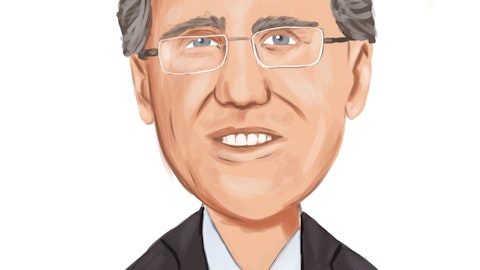Wedgewood Partners, an investment management firm, published its second quarter 2021 investor letter – a copy of which can be downloaded here. A quarterly portfolio return of 11.8% was recorded by the fund for the first half of 2021, outperforming the S&P 500 that delivered an 8.6% return for the same period, but slightly below the 11.9% gain of Russell 1000 Growth Index. You can view the fund’s top 5 holdings to have an idea about their top bets for 2021.
In the Q2 2021 investor letter of Wedgewood Partners, the fund mentioned Copart, Inc. (NASDAQ: CPRT), and discussed its stance on the firm. Copart, Inc. is a Dallas, Texas-based used car dealers company, that currently has a $33.1 billion market capitalization. CPRT delivered a 10.13% return since the beginning of the year, while its 12-month revenues are up by 60.64%. The stock closed at $140.14 per share on July 16, 2021.
Here is what Wedgewood Partners has to say about Copart, Inc. in its Q2 2021 investor letter:
“We first purchased Copart in late 2019. In this review, we will reprint parts of our original commentary on the Company and offer our thoughts on how the Company performed throughout the pandemic.
Copart is the largest company in the automotive salvage and auction industry. The industry is a duopoly, with the Company commanding a +40% market share. Insurance Auto Auctions is the Company’s only competitor of size or scale. The Company generates about 80% of its revenue in the U.S. The other 20% is generated in international markets. The U.K. generates the lion’s share at 15%. The rest is spread out in newer markets that include Canada, Brazil, Ireland, Germany, Spain, the U.A.E., Bahrain, Finland, and Ireland. Copart owns the largest global buying network, which essentially matches global demand with local supply.
The demand for salvage autos is a mix of dismantlers and rebuilders of used and refurbished auto parts that serve the auto repair market, whereby salvaged parts are considerably cheaper than new or OEM parts. Demand for autos that are damaged but worthy of repair has become a staple of international demand, where repaired cars are not subject to onerous safety regulations. With the Company’s advent of nationwide and global online salvage bidding, additional demand for complete, drivable autos from used car dealers and individuals has become quite significant in the demand mix. Insurance companies
processing totaled autos make up the bulk (+87%) of the supply of auctioned autos. Copart has long relationships with State Farm, Allstate, Nationwide, and Farmers. GEICO recently signed on, which could easily yield +130,000 autos per year in supply. Other supply parties include charities, banks, rental car companies, fleet operators, and auto dealers. Copart acts as an agent, earning fees from both buyers and sellers.Arguably the Company’s most significant strategic decision was its very early use of information technology. As early as 1992 Johnson gave auto insurers online access to track salvage sales. These early technology initiatives led to the creation of Copart Auction System (CAS) in 1997, which allowed sellers access to a myriad of information. In 1998 Copart launched a true eBay-like internet-based auction system. The days of the traditional local, in-person salvage auctions were numbered. In 2003 the Company released VB-Squared, which opened up the auction process to registered buyers and sellers on a global basis. Over the past five years, physical inventory more than doubled to over 200 yards, covering 9,000 acres. The Company’s capex continues to accelerate to three times its 10-year average. Today the Company operates 200 yards with over 9,500 acres. On a typical day, the Company has around 200,000 vehicles for sale on its auction website. Today, about 50% of all auction cars are sold inside of state yards, 30% are sold across state lines, and 20% are sold outside the U.S. According to the Company, 75% of all U.S.-based auctions receive a bid from an international buyer.
Scrap and salvage yards have long possessed the classic not-in-my-backyard (NIMBY) competitive advantages. Over the years more stringent local, state, and federal regulations have served to amp up NIMBY attributes. Management early on saw firsthand the economic benefits of local network effects of size and scale in terms of growth and profitability. The network scaling leap from local, to state, to nationwide, and ultimately international, via both hard-asset raw land and a huge fleet of transporters, plus captive insurance companies totaling a greater proportion of accident-damaged autos, combined with technological assets of best-in-class internet-mobile auction sites, has produced manifold operating leverage. To wit, over the past decade, the Company’s average revenue per location has increased over +50% – $7.1 million vs. $4.6 million and average net income per location has soared 150% – $2.0 million vs. $0.79 million.
As 2020 clocks in, Copart is riding a wave of both company-specific growth and industry-specific drivers. On the industry front, Copart’s supply of prospective auctioned and salvaged vehicles continues to be robust thanks to the rise of accident frequencies due to the combination of aging vehicles (almost 12 years on average), increasing driver distractions (smartphones), and rising miles driven (at least in most geographies). In addition, the rising complexity of new autos, particularly since 2014, has resulted in a marked increase in the frequency in total losses from insurance companies. Think of your current newer car as a series of a few dozen small computers (some connected to each one another) and related perimeter sensors and cameras fastened upon four rubber tires.
Even seemingly minor fender benders have become prohibitively expensive to repair due to a wicked combination of expensive electronic parts replacement, the growing time needed to make such repairs and the related cost of insurance plan rental coverage, and the lack of mechanics and auto technicians with the necessary expertise. The resultant lumpy increase in the average selling prices of salvage autos has been a boon to the Company’s bottom line. Such trends will likely never abate and will likely get worse as electric vehicles become mainstream. (Ask a Tesla owner how long it takes a certified mechanic to repair even a small dent in their car and ask them, too, how much their insurance coverage has soared over the past few years.) According to Copart, autos totaled by the insurance industry, which had flat lined at around 14% of total claims, have charted a new path upward each year since 2014 and have now reached 20% of total claims.
The Company’s results through the worst of the pandemic have been mighty impressive, to say the least. Considering that its headquartered in Dallas, plus 17 salvage yards, the historic mid-February winter storm and blackout could not have happened at a worse time. Throughout the pandemic, vehicle accidents were of course lower during lockdown periods, but total loss frequency was actually higher. Higher driving speeds over less congested roads, along with the ever-present smartphone distractions led to higher accident frequency. In addition, the key decades-old driver of more technologically sophisticated vehicles being totaled by insurance companies didn’t skip a beat during the pandemic.
During its second quarter (ending January 31), the Company reported 16 straight quarters of higher average selling auction prices (the quarter during the beginning of the pandemic was the exception), with worldwide ASPs up +35%. The Company has no doubt benefited from the surge in used vehicle prices. Anyone who has tried to buy a new or used auto over the past year knows the story quite well. Vehicle parts shortages due to pandemic-related manufacturing shutdowns, plus an ongoing serious shortage of semiconductor vehicle parts have led to historic new vehicle shortages. Add in stimulus checks to the new demand for used vehicles and prices have skyrocketed.
The Company’s vaunted “flywheel effect” of ever more numerous global buyers and sellers, more numerous inventories, and more numerous bidding in each more numerous auctions creates higher auction liquidity that drives ever-higher company-specific ASPs. Higher auction ASPs drives higher revenues, margin expansion, and operating leverage. During the January quarter, gross margins rose 160 basis points to 49.8%.
During the April quarter global revenue grew +33%. Global gross profit grew +57%. The +48% year-over-year increase in ASP’s drove a stunning +788 basis point year-over-year increase in gross margins +52%. April’s quarter operating leverage was pedal-to-the-metal (bad pun intended) with year-over-year improvement of +926 basis points, leading to a +68% gain in operating income. Non-GAAP income (e.g. currency and stock option tax benefits) was up +65%. Current returns on capital are +30%. Once used and new vehicle supply begins to come back to balance, we expect the inevitable news of “plunging used car prices” to weigh on Copart shares. We hope this comes to pass, as we hope to build a bigger position in the stock.”

Photo by Parker Gibbs on Unsplash
Based on our calculations, Copart, Inc. (NASDAQ: CPRT) was not able to clinch a spot in our list of the 30 Most Popular Stocks Among Hedge Funds. Copart, Inc. was in 49 hedge fund portfolios at the end of the first quarter of 2021, compared to 46 funds in the fourth quarter of 2020. CPRT delivered a 13.49% return in the past 3 months.
Hedge funds’ reputation as shrewd investors has been tarnished in the last decade as their hedged returns couldn’t keep up with the unhedged returns of the market indices. Our research has shown that hedge funds’ small-cap stock picks managed to beat the market by double digits annually between 1999 and 2016, but the margin of outperformance has been declining in recent years. Nevertheless, we were still able to identify in advance a select group of hedge fund holdings that outperformed the S&P 500 ETFs by 115 percentage points since March 2017 (see the details here). We were also able to identify in advance a select group of hedge fund holdings that underperformed the market by 10 percentage points annually between 2006 and 2017. Interestingly the margin of underperformance of these stocks has been increasing in recent years. Investors who are long the market and short these stocks would have returned more than 27% annually between 2015 and 2017. We have been tracking and sharing the list of these stocks since February 2017 in our quarterly newsletter.
At Insider Monkey, we scour multiple sources to uncover the next great investment idea. For example, pet market is growing at a 7% annual rate and is expected to reach $110 billion in 2021. So, we are checking out the 5 best stocks for animal lovers. We go through lists like the 10 best battery stocks to pick the next Tesla that will deliver a 10x return. Even though we recommend positions in only a tiny fraction of the companies we analyze, we check out as many stocks as we can. We read hedge fund investor letters and listen to stock pitches at hedge fund conferences. You can subscribe to our free daily newsletter on our homepage.
Disclosure: None. This article is originally published at Insider Monkey.




